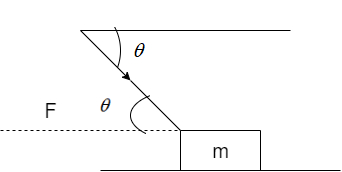
A block of mass m slides along a surface where \[\mu \]is the coefficient of kinetic friction. A man pushes the block with a force F which makes an angle$\theta $with the horizontal as shown below. The block moves with constant velocity v. Power delivered by the man is:

A) $0$
B) $[F.v\cos \theta ]$
C) $[F\cos \theta - \mu (mg + F\sin \theta )]v$
D) $[F\cos \theta + \mu (mg + F\sin \theta )]v$$$
Answer
216k+ views
Hint: Recall that the frictional force is defined as the force that opposes the motion of the object when two surfaces are in contact with each other. The frictional force always acts in a direction opposite to the direction of motion of the object. It also varies with the type of surface of the object.
Complete step by step solution:
Since force is a vector quantity, it will have two components. One in horizontal direction which is $F\cos \theta $ and the other is vertical component which is $F\sin \theta $.
Also the normal force N will act in an upward direction and the weight ‘mg’ will act in a downward direction.
Also the coefficient of friction is given by the formula,
$\mu = \dfrac{F}{N}$
Where F is the frictional force
And N is the normal force
$F = \mu N$---(i)
The component of force along horizontal direction is $F\cos \theta $.
$\therefore $equation (i) can be written as
$F\cos \theta - \mu N = 0$---(ii)
The normal force is balanced by the vertical component of force and weight ‘mg’ as they are acting in an opposite direction to the force. Therefore, it can be written as
$\Rightarrow N = mg + F\sin \theta $---(iii)
Substituting the value of N from equation (iii) in equation (ii),
$\Rightarrow F\cos \theta - \mu [mg + F\sin \theta ] = 0$---(iv)
When an object is moving with a constant velocity with some applied force, the formula for power is written as
$Power = Force \times Velocity$
Substituting the value of force, from equation (iv)
$\Rightarrow P = [F\cos \theta - \mu (mg + F\sin \theta )]v$
The power delivered by the man is
$\Rightarrow P = [F\cos \theta - \mu (mg + F\sin \theta )]v$
Option (C) is the right answer.
Note: It is important to remember that the coefficient of friction is the ratio of frictional force and the normal force. When there is a lot of friction between the two surfaces, then the value of coefficient of friction is high. It measures how one object moves in relation to another object in contact.
Complete step by step solution:
Since force is a vector quantity, it will have two components. One in horizontal direction which is $F\cos \theta $ and the other is vertical component which is $F\sin \theta $.
Also the normal force N will act in an upward direction and the weight ‘mg’ will act in a downward direction.
Also the coefficient of friction is given by the formula,
$\mu = \dfrac{F}{N}$
Where F is the frictional force
And N is the normal force
$F = \mu N$---(i)
The component of force along horizontal direction is $F\cos \theta $.
$\therefore $equation (i) can be written as
$F\cos \theta - \mu N = 0$---(ii)
The normal force is balanced by the vertical component of force and weight ‘mg’ as they are acting in an opposite direction to the force. Therefore, it can be written as
$\Rightarrow N = mg + F\sin \theta $---(iii)
Substituting the value of N from equation (iii) in equation (ii),
$\Rightarrow F\cos \theta - \mu [mg + F\sin \theta ] = 0$---(iv)
When an object is moving with a constant velocity with some applied force, the formula for power is written as
$Power = Force \times Velocity$
Substituting the value of force, from equation (iv)
$\Rightarrow P = [F\cos \theta - \mu (mg + F\sin \theta )]v$
The power delivered by the man is
$\Rightarrow P = [F\cos \theta - \mu (mg + F\sin \theta )]v$
Option (C) is the right answer.
Note: It is important to remember that the coefficient of friction is the ratio of frictional force and the normal force. When there is a lot of friction between the two surfaces, then the value of coefficient of friction is high. It measures how one object moves in relation to another object in contact.
Recently Updated Pages
JEE Atomic Structure and Chemical Bonding important Concepts and Tips

JEE Amino Acids and Peptides Important Concepts and Tips for Exam Preparation

Electricity and Magnetism Explained: Key Concepts & Applications

Chemical Properties of Hydrogen - Important Concepts for JEE Exam Preparation

JEE Energetics Important Concepts and Tips for Exam Preparation

JEE Isolation, Preparation and Properties of Non-metals Important Concepts and Tips for Exam Preparation

Trending doubts
JEE Main 2026: Application Form Open, Exam Dates, Syllabus, Eligibility & Question Papers

Derivation of Equation of Trajectory Explained for Students

Hybridisation in Chemistry – Concept, Types & Applications

Understanding the Angle of Deviation in a Prism

Understanding Collisions: Types and Examples for Students

How to Convert a Galvanometer into an Ammeter or Voltmeter

Other Pages
JEE Advanced Marks vs Ranks 2025: Understanding Category-wise Qualifying Marks and Previous Year Cut-offs

Units And Measurements Class 11 Physics Chapter 1 CBSE Notes - 2025-26

NCERT Solutions For Class 11 Physics Chapter 8 Mechanical Properties Of Solids

Motion in a Straight Line Class 11 Physics Chapter 2 CBSE Notes - 2025-26

NCERT Solutions for Class 11 Physics Chapter 7 Gravitation 2025-26

Ideal and Non-Ideal Solutions Explained for Class 12 Chemistry




